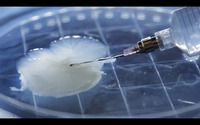 Bioprinting is something you’ll be hearing a lot more about in the future. It’s the application of 3D printing for medical purposes.
Bioprinting is something you’ll be hearing a lot more about in the future. It’s the application of 3D printing for medical purposes. The idea is to produce human tissue for replacement of damaged portions, but it’s much more complicated than 3D printing simple plastic objects. Not only are you dealing with microscopic bits, but they are also alive!
The process typically involves printing a “scaffold” made of a dissolvable material that supports the actual living cells extracted from the patient to avoid “tissue rejection”. The cells then grow over the scaffold and when it eventually dissolves, you’ve got tissue cells organized in the correct manner. Additional complexities arrive when you consider that human organs involve many different kinds of cells, unlike typical 3D printed plastic objects that are made from a single material.
ABC News interviewed Dr. Anthony Atala, who’s leading a team of 300 researchers at the Wake Forest Institute for Regenerative Medicine in North Carolina. He’s been experimenting with growing replacement organs based on cells from the patient and has been quite successful. Starting from growing a replacement human bladder in 1998, the team is now testing 30 different human organs and various body tissues. For example, they’ve developed techniques to seal battle wounds by printing healthy skin cells over the damaged area. They’re still working on actual organs, which obviously are much more complex.
Is this approach ready for regular hospital use? Not quite. It still involves significant work by teams of people to ensure a successful result. However, as research continues it’s likely efficiencies will be identified and implemented, leading to a future where you’ll be able to grow your own replacements.
Via ABCNews

